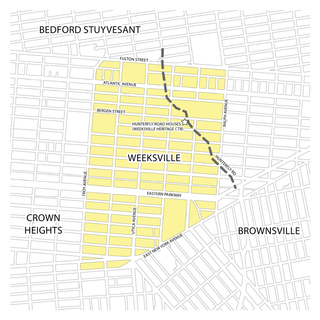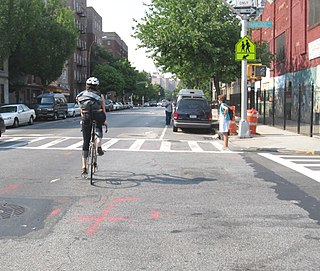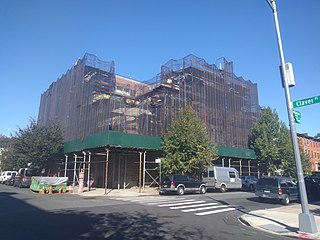
Crown Heights is a neighborhood in the central portion of the New York City borough of Brooklyn. Crown Heights is bounded by Washington Avenue to the west, Atlantic Avenue to the north, Ralph Avenue to the east, and Empire Boulevard/East New York Avenue to the south. It is about one mile (1.6 km) wide and two miles (3.2 km) long. Neighborhoods bordering Crown Heights include Prospect Heights to the west, Flatbush and Prospect Lefferts Gardens to the south, Brownsville to the east, and Bedford–Stuyvesant to the north.

Bedford–Stuyvesant, colloquially known as Bed–Stuy, is a neighborhood in the northern section of the New York City borough of Brooklyn. Bedford–Stuyvesant is bordered by Flushing Avenue to the north, Classon Avenue to the west, Broadway to the east, and Atlantic Avenue to the south. The main shopping street, Fulton Street, runs east–west the length of the neighborhood and intersects high-traffic north–south streets including Bedford Avenue, Nostrand Avenue, and Stuyvesant Avenue. Bedford–Stuyvesant contains four smaller neighborhoods: Bedford, Stuyvesant Heights, Ocean Hill, and Weeksville. Part of Clinton Hill was once considered part of Bedford–Stuyvesant.

Ocean Hill is a subsection of Bedford–Stuyvesant in the New York City borough of Brooklyn. The neighborhood is part of Brooklyn Community Board 16 and was founded in 1890. The ZIP code for the neighborhood is 11233. Ocean Hill's boundaries start from Broadway and the neighborhood of Bushwick in the north, Ralph Avenue and the neighborhoods of Bedford–Stuyvesant proper and Crown Heights to the west, East New York Avenue and the neighborhood of Brownsville to the south, and Van Sinderen Avenue and the neighborhood of East New York to the east.
New York's 8th congressional district for the U.S. House of Representatives is in the New York City borough of Brooklyn. It is currently represented by Representative Hakeem Jeffries, the House Minority Leader.

Weeksville is a historic neighborhood founded by free African Americans in what is now Brooklyn, New York, United States. Today it is part of the present-day neighborhood of Crown Heights.

Hattie Carthan was an American community activist and environmentalist who was instrumental in improving the quality of life of the Brooklyn, New York community of Bedford-Stuyvesant.
The demographics of Brooklyn reveal a very diverse borough of New York City and a melting pot for many cultures, like the city itself. Since 2010, the population of Brooklyn was estimated by the Census Bureau to have increased 3.5% to 2,592,149 as of 2013, representing 30.8% of New York City's population, 33.5% of Long Island's population, and 13.2% of New York State's population. If the boroughs of New York City were separate cities, Brooklyn would be the third largest city in the United States after Los Angeles and Chicago.

The Audre Lorde Project is a Brooklyn, New York–based organization for LGBTQ people of color. The organization concentrates on community organizing and radical nonviolent activism around progressive issues within New York City, especially relating to LGBTQ communities, AIDS and HIV activism, pro-immigrant activism, prison reform and organizing among youth of color. It is named for the lesbian-feminist poet and activist Audre Lorde and was founded in 1994.

Bedford Avenue is the longest street in Brooklyn, New York City, stretching 10.2 miles (16.4 km) and 132 blocks, from Manhattan Avenue in Greenpoint south to Emmons Avenue in Sheepshead Bay, and passing through the neighborhoods of Williamsburg, Bedford–Stuyvesant, Crown Heights, Flatbush, Midwood, Marine Park, and Sheepshead Bay.

The Universal Hip Hop Parade(UHHP) is an annual cultural event held in the historically Black neighborhood of Bedford–Stuyvesant, Brooklyn, New York City, on the Saturday before the anniversary of Marcus Garvey's birthday each August 17. The parade is a reminder that Marcus Garvey himself also used popular culture as a tool to empower people and encouraged the growth of Black institutions.

The Brooklyn Waldorf School is a coeducational, independent, non-sectarian day preschool and elementary Waldorf school located in Bedford-Stuyvesant, Brooklyn, New York. The school operates on the principles of Waldorf Education and adapts the traditional methods of Rudolf Steiner. The school was founded in 2005 and currently has a Preschool/Kindergarten and Grades 1–8. In 2011, the Brooklyn Waldorf School moved into its new home at the Claver Castle.

Broadway is an avenue in the New York City borough of Brooklyn that extends from the East River in the neighborhood of Williamsburg in a southeasterly direction to East New York for a length of 4.32 miles (6.95 km). It was named for the Broadway in Manhattan. The East New York terminus is a complicated intersection with East New York Avenue, Fulton Street, Jamaica Avenue, and Alabama Avenue. The BMT Jamaica Line of the New York City Subway runs on elevated tracks over Broadway from the Williamsburg Bridge to East New York on its way to Queens. Broadway forms the boundary between the neighborhoods of Bushwick, which lies above Broadway to the northeast, and Bedford–Stuyvesant, which is to the southwest.

The Billie Holiday Theatre is an AUDELCO and Obie Award-winning theatre that aims to provide "complete and authentic portrayals" of the African diaspora experience, as well as "artistic and institutional residencies and ... educational programming to people of all ages."
Central Brooklyn consists of several neighborhoods often grouped together because of their large populations of African Americans and Caribbean Americans. Central Brooklyn is the largest collection of black communities in both New York City and the United States. These neighborhoods include:

The Bedford Stuyvesant Restoration Corporation is a community development corporation based in Brooklyn, New York, and the first ever to be established in the United States.

The United Order of Tents is an organization for African-American churchwomen founded in Norfolk, Virginia, in 1867 by Annetta M. Lane and Harriet R. Taylor. There are chapters across the United States. It is a secret society, with parts of membership and organizing only shared with members. It is the oldest benefit society for black women in the United States. At its height, national membership reached approximately 50,000 women.
Milton Arthur Galamison was a Presbyterian minister who served in Brooklyn, New York. As a community activist, he championed integration and education reform in the New York City public school system, and organized two school boycotts.
The house located on 87 MacDonough Street in Bedford–Stuyvesant, Brooklyn has been a part of the Bedford-Stuyvesant/Stuyvesant Heights Historic District since 1975. It is one of the oldest surviving structures in the neighborhood dating back to its construction in 1863. It is currently owned by the United Order of Tents.
Elsie Richardson was a community activist and civil servant in Brooklyn, New York. She is best known for founding the Central Brooklyn Coordinating Council and contributing to the Bedford Stuyvesant Restoration Corporation, created after she advocated to Robert F. Kennedy.













